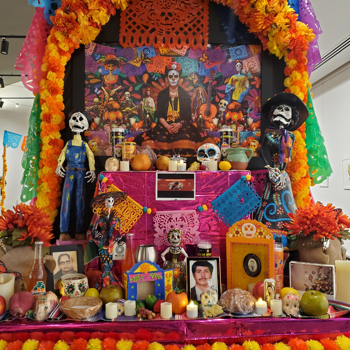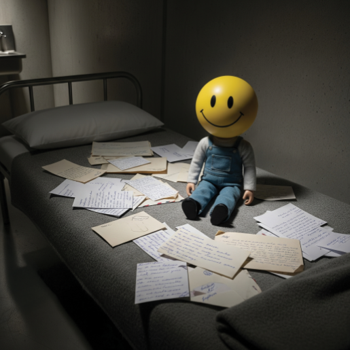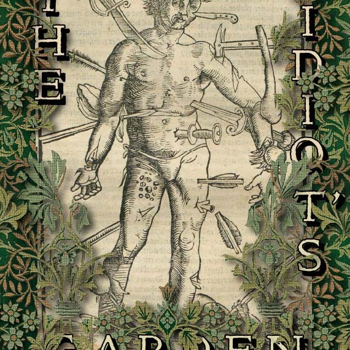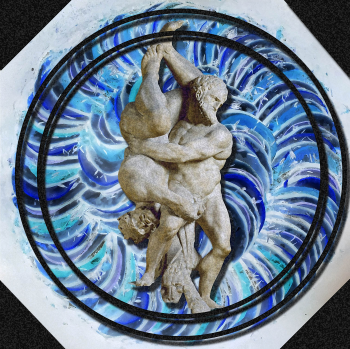Tube Light
 Artwork by Gomathy Ganesan
Artwork by Gomathy Ganesan
Daylight, bright but not too bright, like it is on a cloudy day, a soft white with bluish overtones; radiating from the middle of the dark brown uneven wood ceiling at a height of about eight feet, the white fluorescent tube illuminated our faces making us blink and squint. I noticed details on my sister’s hair that I had not seen in a while, little curls, and the thinned-out ends. For the first time I caught a glimpse of tiny black ants in a slow-moving procession, destined, I would assume, for a small crevice in the wall plaster which was not yet obvious to me. I could make out so many details on the dull, aging, red brick floor—the numerous stains, cracks, dirt spots, and the uneven surface. No wonder, whenever we mopped the floor, numerous dirty streams would emerge simultaneously, eventually organizing into multiple puddles, some visible, many hidden under the furniture, or just pooled in the dark corners of the room. I could pick out a lot more details from the faces of extended family members casually staring at us from the comfort of the framed black and white photographs hanging on the walls. The dust on the glass protecting the photos obscured some finer features and a thick layer of fine dust settled like sediment was clearly visible on the top edge of the frames. None of this could dampen our elated mood, lower the flight altitudes of our spirits, or reduce the sheer joy that seemed to radiate from a bright luminescent tube.We lived in a row house on a long narrow street. There were about fifty houses, some big and others small, in colonial style with two floors, on each side of the road. The houses faced east or west and ours was sandwiched in the middle of the street on the side with houses facing west. The houses had a frontage of about 12-15 feet making a block length of 650 feet or so, about a tenth of a mile. None of the houses had a front yard, with the front porch or the veranda as we usually referred to it, starting right at the edge of the road behind a couple of steps under which an open drain ran parallel to the road, one on either side. A typical row house was long and narrow with a living room behind the front porch, a bedroom, a dining room, followed behind by a pantry and the kitchen. There was an open bath with a deep well, a shower, and then a back porch for mainly storing firewood needed for the woodstove. The back porch led to the backyard with a solitary segregated toilet with a septic tank underneath. While I was growing up in the sixties of the last century, we had electricity and running water but no proper drainage to speak of. A staircase led from the living room to a single large bedroom upstairs. The living room had a closet but neither the bedrooms nor any of the other rooms had any enclosed storage space; however, the dark pantry had some built-in shelving.
As you can easily guess, the house was not sunlit much throughout the day. Late afternoon, for a few minutes, the golden rays of the Sun would penetrate the upstairs windows and illuminate the bedroom. None of the ground floor rooms received any direct sunlight.
It all started innocuously, out of curiosity, this play with sunlight and mirror. But thinking back, reflecting, and ruminating now after many decades, I feel a strong sense of regret. The row house across from ours facing east was the largest in our street with a frontage about three times ours. The lady of the house always used to be dressed in colorful silk saris and she wore lots of gold jewelry. She had three grown up daughters, one was in high school, and the others were in college. Her husband was a businessman who travelled a lot and was hardly around.
The woman’s dad, bald with thin gray hair on the sides and wearing thick reading glasses, could always be seen late afternoons sitting at a desk near the large window of the second-floor bedroom reading. Spread on his desk were two or three voluminous books and a bookcase nearby had a stack of oversized books. One afternoon, out of curiosity, when the desk was unoccupied, I used a mirror to reflect sunlight through the open window onto the books to see if I could make out any of the titles. The old man walked in and became perplexed seeing the beam of light illuminating his books. To distract him from seeing me I focused the light on his face. Confused and partly blinded he started pacing the room like a trapped panther. He couldn’t look in the direction of the light; otherwise, he would have seen me. He turned away from the beam of light and started walking away. I didn’t want to get caught in my act of mischief. I put away my mirror and tiptoed down as if nothing had happened.
My grandma told me that all the row houses in the neighborhood were built during the mid-nineteenth century. There was no running water or electricity in those days; these utilities arrived much later. Running water was introduced in the city after the first world war, sometimes in the early 1920s. Electricity had to wait much longer which finally came on the eve of the second world war in the late 1930s. There was one incandescent light bulb holder in each of the major rooms illuminated mostly by 25W bulbs and an occasional 40W light source. Electricity was expensive and we had strict ground rules for turning the lights on and off. No light was to be turned on when there was daylight, and when the lamps were finally switched on after darkness set in, there was barely enough light to read. The upstairs room had the brighter bulb, and an oscillating table fan sat on the floor. Though we were quite curious we were not allowed to operate the fan at all. The upstairs room was allocated for my grown-up cousin. We did not have any ceiling fans in the house though I had seen them in my friends’ houses. We also did not have a radio in those days.
My grandma used to tell me electricity stories and she would get quite animated while narrating them. She never went to school or learned to read or write but enjoyed telling stories. I learned from her that electricity was introduced in phases in the city streets by erecting lamp posts at street corners starting in the late 1920s. One of the earliest public places in our subdivision to get lighting was the nearby public, an easy ten-minute walk from our house. There used to be an oil-burning streetlamp originally, but it was never bright, and the oil ran out in an hour or so. When it became electric, later on, it started burning from sunset through midnight when it was turned off, that is what my grandma thought. Grandpa and his high school friends and many college-going students would study for a few hours daily sitting in the park circling the base of the lamp post.
Grandpa remembered a guy who repaired leather shoes, sandals, bags, and suitcases in the square near the park. He would always have a tall stack of books, big leather-bound volumes, some old and yellowing, and some new ones. Grandpa assumed that the guy was doing custom leather binding for different clients. There were books on religion, world and Indian history, literature, politics, and current affairs. He could make out some of the titles, there was the Valmiki Ramayana, the Mahabharata, and the Koran, War and Peace, A Tale of Two Cities, The Hunchback of Notre Dame, History of Africa, History of South America, History of Europe, Literary Criticism, and many others. Grandpa had not even heard of most of the titles the shoe repair person kept or had seen them only in libraries and big book shops. When grandpa started reading by the streetlight, he always found the shoe repair guy huddled at the base of the lamp with two or three of his volumes, engrossed in reading, and meticulously taking notes. This went on for many days. The guy would be there when grandpa got there at seven in the evening, and, continued sitting and studying when grandpa left for home at 9 pm on some days or at 10 pm on some other days.
Surprised by the big-book-reader getting up to leave early one day, grandpa asked him— Are you studying and preparing for some special exams? And, he said— Yes, the ICS (Indian Civil Service) exams are starting tomorrow. I need to wake up early and walk a few miles to the test center. Saying that he walked away. That was the last time grandpa saw him.
Grandma would tell this story she had heard from grandpa with great excitement. Grandpa had also told her that the guy passed his exams and later became the civil administrator of a faraway district. I also heard about the independence leader and freedom fighter Netaji Subhash Chandra Bose who gave up his ICS title to protest British colonial policies and continue his freedom struggle to liberate the country.
Indeed, electricity first came to our city as street lamps to illuminate roads, parks, and other public spaces. Then it entered households to light up rooms after dark to facilitate reading and schoolwork. It duly lit up shops, businesses, offices, and other establishments. But traffic control and management at major intersections were still being administered by traffic cops. They stood on raised platforms with built-in rain shades from dawn to dusk and manually guided the traffic flow using handheld signs, animated gestures, and whistles. It was quite amusing to watch them; they appeared to be a strange blend of circus clowns and sign language interpreters.
Traffic lights came to the city much later. When the first traffic light was introduced in one major intersection, it created a buzz in the city and inside households. The daily newspapers ran features about it. It quickly became a hot topic of dinner conversation in homes as though it was a major political event, a natural disaster, or a landing of aliens in the city plaza. The maiden traffic light soon became a major attraction in the city. Families would set out to watch the lights turn red and green. After a trial of a few days, it became three colors—green, yellow and red. We also made a beeline to watch the magic light and were quite thrilled to see the light go from green, to yellow to red and then circle back to green again. It gave me the feeling of watching the rainbow for the first time as a kid. It seemed magical at the outset, but as we stood there observing, we saw traffic backing up in the North-South direction. The vehicular flow was quite thin East-West. We realized that the lights were changing colors at the same preset intervals on all the four sides.
I did not have to read by the light of a streetlamp. Growing up, we had electricity in the house, and, by extension electric lamps which could be magically turned on by the flip of a switch. The only restriction was that we could only turn on the lights between 7 pm and 10 pm on school days and from 7 pm to 9 pm on weekends and holidays. On cloudy days and in winter I would walk to the public park with a book in hand and read sitting on a bench till daylight faded and then walk back home.
A cousin from Cochin visited us and stayed for a few days. We assumed he had a well-paying comfortable job. He took us all to the Shimla ice cream parlor a couple of miles from our house on the main thoroughfare of the city named MG road after Mahatma Gandhi. We were thrilled to see so many flavors of ice cream in a variety of colors. The ice cream display in a variety of flavors and colors reminded me of the rainbow I had seen in Shankumugham beach. We had gone to the seashore to observe the setting Sun. Suddenly, clouds appeared from nowhere and it started to drizzle. Many people gathered on the beach left suddenly fearing a heavy downpour. But we stayed put. The drizzle stopped after a few minutes, the clouds gradually dissolved and dissipated, and the Sun started shining again. We were watching the setting Sun losing altitude and descending towards the horizon. There was a shuffle of feet, and many people were turning and looking in the opposite direction. Reversing our gaze, we saw this majestic rainbow vibrant in so many distinct colors.
I got two scoops, chocolate and pista flavors. Sitting down to savor the delicacy my attention turned to the soft bright white light filling the parlor. It resembled the outside daylight. I looked up at the ceiling and saw a long tubular white glow radiating light in all directions. My eyes were blinking but fixated at the bright white light. I had never seen a long tube of light like that before. It would be so nice to read under such a light!
Later that evening I overheard my cousin discussing with my parents about hiring an electrician. And there he was, early afternoon the following day, with a long brown cardboard box and a set of tools. He got started with the work and all our gazes turned towards him, and the long white mystery tube he had just unpacked and unwrapped. After about an hour or so, which seemed like ages, the darkest room in our house became the brightest at the flip of a switch. It seemed as if a narrow tubular Sun wrapped in clouds sneaked into our room and latched on to the central beam of the wood ceiling.
And I thought— the Russians sent Yuri Gagarin into space in a spacecraft and brought him safely back to earth; I remembered my elementary school teacher saying in class that the Americans will soon put a man on the moon. At least we have an electric traffic light in the city and a tube light to brighten our tubular home. Still, I felt pride.
The rainbow, traffic light and the tube light all held some mystery. Later, in school, our middle-school science teacher brought a small glass pyramid which she called a prism. Positioning it against a beam of white light we could see a spattering of colors like a rainbow on the wall. Another time she brought a wheel painted with seven colors “VIBGYOR” and when the disc was spinning fast it magically turned white. A white disc was all we could visualize. It was beyond our comprehension.
Years later in high school it would somehow motivate me to grow fruit flies in vials and expose them to a variety of colored light. Strangely, the tube light in our ancestral tubular row-house started it all—my inquiries into various phenomena, both natural and man-made we see around us.
The Sun sustains life on this planet. Without sunlight all life forms will become extinct. And the tube light succeeded in illuminating the dark corners of our row house enabling us to see a lot more beyond what could be seen before.
It took me a while to grasp the function, the essence, and the meaning of light. The rainbow, daylight, the setting sunlight, incandescent light, and the light rays emanating from the fluorescent tube brought scenes to life, illuminated book pages to tell stories, lightened up faces making them recognizable, and painted everything in the colors of life. Light is pure joy, I thought. These images would then be stored as memories in the brain to be retrieved at your will and pleasure. A magical photosynthesis of the granular snapshots of life was being turned into layered memories; the Sun started it all for the world at large, and the tube light inaugurated it in a big way in our tubular row-house whenever the Sun went to sleep.





